MaryAnn Bernal's Blog, page 234
September 26, 2014
Ancient Stone Toolmaking Didn't Just Spread Out of Africa with Humans
By Charles Q. Choi
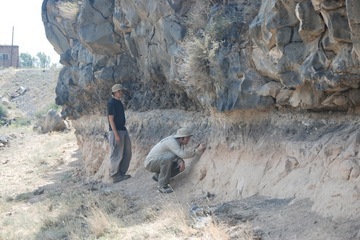 The artifacts were discovered in 2008, after the Armenian military bulldozed a road and uncovered the ancient stone tools.
The artifacts were discovered in 2008, after the Armenian military bulldozed a road and uncovered the ancient stone tools.
Credit: Daniel S. Adler
An advanced way of crafting stone tools, once thought to have only originated in Africa, may have been invented elsewhere independently, according to a new study. The finding provides evidence that this ancient technology did not spread across the world solely as a result of humanity's exodus from Africa, researchers say.
Between 200,000 to 300,000 years ago in Eurasia and in Africa, ancient humans developed a sophisticated kind of stone tool production method known as Levallois technology, named after the site where it was first discovered in France. Levallois technology involves knocking stone flakes of specific sizes and shapes off a lump of stone, called a core.
The resulting flakes, with all of their edges sharpened by the earlier trimming work, are refined into knives or other tools, relatively small items that would have been easy to carry — an important consideration for the highly mobile hunter-gatherers of the time. [See photos of the ancient stone artifacts]
Before Levallois technology, early humans used a different approach called bifacial technology, where a mass of stone is shaped through the removal of flakes from a rock in order to produce a tool such as a hand axe, and most of the flakes are discarded. Archaeologists suggest that Levallois technology was more economical because fewer raw materials were wasted in the process.
Researchers have argued that Levallois technology was invented in Africa, and that this innovation eventually spread to Eurasia with the exodus of humans from Africa. As a result, this new way of building stone tools would have replaced local bifacial technologies. However, investigators have now found the earliest known use of Levallois technology in Eurasia. The discovery serves as the first clear evidence that Levallois technology arose independently outside of Africa.
Scientists investigated nearly 3,000 stone artifacts excavated from an archaeological site in Armenia known as Nor Geghi 1, or NG1. In the 1990s, the Armenian military had bulldozed a road from the group's base, exposing the artifacts, which the archaeologists discovered in 2008.
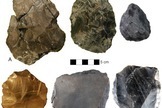
[image error] The artifacts in the top row (A) were created with an approach known as bifacial technology, in which two surfaces are used to remove flakes and shape the stone. The artifacts in the bottom row (B) were crafted using a method known as Levallois technology, which involves using a hammer to knock stone flakes of specific sizes and shapes off a lump of stone.
The artifacts in the top row (A) were created with an approach known as bifacial technology, in which two surfaces are used to remove flakes and shape the stone. The artifacts in the bottom row (B) were crafted using a method known as Levallois technology, which involves using a hammer to knock stone flakes of specific sizes and shapes off a lump of stone.
Credit: Daniel S. Adler
View full size imageThe site was preserved between two lava flows that date back 200,000 and 400,000 years ago. Analysis of the sediments and volcanic ash found between the lava flows suggests that the artifacts were between 325,000 and 335,00 years old. Back then, the area was "a floodplain, a beautiful, open vegetated landscape," with a continental climate similar to today's, said lead study author Daniel Adler, a Paleolithic archaeologist at the University of Connecticut in Storrs.
The stone artifacts, which were made from the volcanic rock obsidian, revealed that people there used both bifacial and Levallois technology at the same time, the earliest evidence of the coexistence of these technologies. The populations there apparently gradually developed Levallois technology out of bifacial technology, the researchers said.
This finding reveals that this technological innovation occurred intermittently throughout the Old World, rather than spreading from a single point of origin, as was previously thought. This highlights the antiquity of the human capacity for innovation, the researchers said.
"Technological innovation was something that our ancestors were very good at," Adler told Live Science.
In addition, chemical analysis of more than 300 obsidian artifacts revealed that humans at the site gathered materials from rocky outcrops as far away as 75 miles (120 kilometers). This suggests that they must have been capable of exploiting large, environmentally diverse territories, according to the researchers.
It remains uncertain who produced these artifacts, but they predate the emergence of modern humans about 200,000 years ago in Africa. Modern humanswere not the only human lineages to walk the Earth — other, so-called archaic humans once lived in Africa and Eurasia.
The scientists detailed their findings in the Sept. 26 issue of the journal Science.
Live Sciencel
 The artifacts were discovered in 2008, after the Armenian military bulldozed a road and uncovered the ancient stone tools.
The artifacts were discovered in 2008, after the Armenian military bulldozed a road and uncovered the ancient stone tools.Credit: Daniel S. Adler
An advanced way of crafting stone tools, once thought to have only originated in Africa, may have been invented elsewhere independently, according to a new study. The finding provides evidence that this ancient technology did not spread across the world solely as a result of humanity's exodus from Africa, researchers say.
Between 200,000 to 300,000 years ago in Eurasia and in Africa, ancient humans developed a sophisticated kind of stone tool production method known as Levallois technology, named after the site where it was first discovered in France. Levallois technology involves knocking stone flakes of specific sizes and shapes off a lump of stone, called a core.
The resulting flakes, with all of their edges sharpened by the earlier trimming work, are refined into knives or other tools, relatively small items that would have been easy to carry — an important consideration for the highly mobile hunter-gatherers of the time. [See photos of the ancient stone artifacts]
Before Levallois technology, early humans used a different approach called bifacial technology, where a mass of stone is shaped through the removal of flakes from a rock in order to produce a tool such as a hand axe, and most of the flakes are discarded. Archaeologists suggest that Levallois technology was more economical because fewer raw materials were wasted in the process.
Researchers have argued that Levallois technology was invented in Africa, and that this innovation eventually spread to Eurasia with the exodus of humans from Africa. As a result, this new way of building stone tools would have replaced local bifacial technologies. However, investigators have now found the earliest known use of Levallois technology in Eurasia. The discovery serves as the first clear evidence that Levallois technology arose independently outside of Africa.
Scientists investigated nearly 3,000 stone artifacts excavated from an archaeological site in Armenia known as Nor Geghi 1, or NG1. In the 1990s, the Armenian military had bulldozed a road from the group's base, exposing the artifacts, which the archaeologists discovered in 2008.

[image error]
 The artifacts in the top row (A) were created with an approach known as bifacial technology, in which two surfaces are used to remove flakes and shape the stone. The artifacts in the bottom row (B) were crafted using a method known as Levallois technology, which involves using a hammer to knock stone flakes of specific sizes and shapes off a lump of stone.
The artifacts in the top row (A) were created with an approach known as bifacial technology, in which two surfaces are used to remove flakes and shape the stone. The artifacts in the bottom row (B) were crafted using a method known as Levallois technology, which involves using a hammer to knock stone flakes of specific sizes and shapes off a lump of stone.Credit: Daniel S. Adler
View full size imageThe site was preserved between two lava flows that date back 200,000 and 400,000 years ago. Analysis of the sediments and volcanic ash found between the lava flows suggests that the artifacts were between 325,000 and 335,00 years old. Back then, the area was "a floodplain, a beautiful, open vegetated landscape," with a continental climate similar to today's, said lead study author Daniel Adler, a Paleolithic archaeologist at the University of Connecticut in Storrs.
The stone artifacts, which were made from the volcanic rock obsidian, revealed that people there used both bifacial and Levallois technology at the same time, the earliest evidence of the coexistence of these technologies. The populations there apparently gradually developed Levallois technology out of bifacial technology, the researchers said.
This finding reveals that this technological innovation occurred intermittently throughout the Old World, rather than spreading from a single point of origin, as was previously thought. This highlights the antiquity of the human capacity for innovation, the researchers said.
"Technological innovation was something that our ancestors were very good at," Adler told Live Science.
In addition, chemical analysis of more than 300 obsidian artifacts revealed that humans at the site gathered materials from rocky outcrops as far away as 75 miles (120 kilometers). This suggests that they must have been capable of exploiting large, environmentally diverse territories, according to the researchers.
It remains uncertain who produced these artifacts, but they predate the emergence of modern humans about 200,000 years ago in Africa. Modern humanswere not the only human lineages to walk the Earth — other, so-called archaic humans once lived in Africa and Eurasia.
The scientists detailed their findings in the Sept. 26 issue of the journal Science.
Live Sciencel

Published on September 26, 2014 10:35
History Trivia - The Parthenon in Athens is severely damaged by a gunpowder explosion
Sept 26

46 BC Julius Caesar dedicated a temple to his mythical ancestor Venus Genetrix in accordance with a vow he made at the battle of Pharsalus.
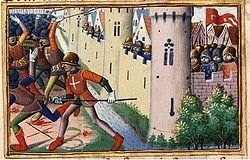
715 Ragenfrid defeated Theudoald at the Battle of Compiègne, the first definite battle of the civil war which followed the death of Pepin of Heristal, Duke of the Franks.

1687 The Parthenon in Athens, unscathed since 432 BC, was severely damaged by a gunpowder explosion, caused by the bombing from Venetian forces led by Morosini (Doge of Venice) who besieged the Ottoman Turks stationed in Athens.


46 BC Julius Caesar dedicated a temple to his mythical ancestor Venus Genetrix in accordance with a vow he made at the battle of Pharsalus.

715 Ragenfrid defeated Theudoald at the Battle of Compiègne, the first definite battle of the civil war which followed the death of Pepin of Heristal, Duke of the Franks.

1687 The Parthenon in Athens, unscathed since 432 BC, was severely damaged by a gunpowder explosion, caused by the bombing from Venetian forces led by Morosini (Doge of Venice) who besieged the Ottoman Turks stationed in Athens.

Published on September 26, 2014 04:57
September 25, 2014
Audio Book Launch - The Night I Danced with Rommel by Elisabeth Marrion

‘May I have this dance, Hilde’ asked Field Marshal Rommel, opening the Grande Ball held in his honour.
Did this dance save the life of Hilde’s Polish friends?
Hilde had come a long way since her dream of becoming a singer was shattered when her father made arrangements for her to work as a housekeeper in Berlin at the tender age of fourteen.
Hilde’s life is thrown into turmoil in Berlin during the late 1920’s early 1930’s. Having Polish friends meant it was becoming increasingly unsafe for her to stay there and she finds a new life in the Harz mountains.
In Goslar, Hilde meets her husband, Karl, a young officer in the German Army.
When he joins the 7th Panzer Brigade led by General Erwin Rommel at the beginning of World War II, Hilde is left to bring up their children in war-torn Germany.
Hilde’s story is based on facts and is told here by her youngest daughter, Elisabeth.
iTunes Link
Audible Link

Published on September 25, 2014 07:23
History Trivia - Harold II (Harold Godwinson) of England defeats Harald Hardrada of Norway, at Stamford Bridge near York,
Sept 25
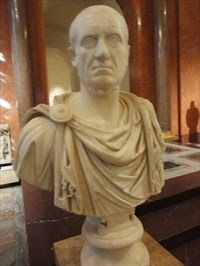
275 The Roman Senate proclaimed Marcus Claudius Tacitus Emperor after the assassination of Aurelian. During his short reign he campaigned against the Goths and the Heruli, for which he received the title Gothicus Maximus.
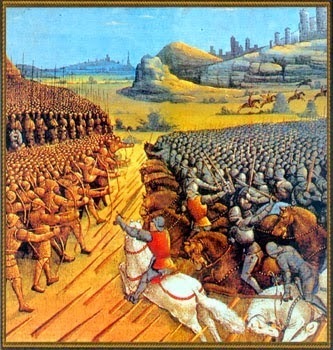
396 Ottoman Emperor Bayezid I defeated a Christian army at the Battle of Nicopolis, often referred to as the Crusade of Nicopolis and was the last large-scale crusade of the Middle Ages.

1066 Harold II (Harold Godwinson) of England defeated an invasion by Harald Hardrada of Norway, at Stamford Bridge near York, and marked the end of the Viking invasions of England. It also delayed Harold's arrival at Hastings, becoming a significant factor in the outcome of the Norman Conquest.


275 The Roman Senate proclaimed Marcus Claudius Tacitus Emperor after the assassination of Aurelian. During his short reign he campaigned against the Goths and the Heruli, for which he received the title Gothicus Maximus.

396 Ottoman Emperor Bayezid I defeated a Christian army at the Battle of Nicopolis, often referred to as the Crusade of Nicopolis and was the last large-scale crusade of the Middle Ages.

1066 Harold II (Harold Godwinson) of England defeated an invasion by Harald Hardrada of Norway, at Stamford Bridge near York, and marked the end of the Viking invasions of England. It also delayed Harold's arrival at Hastings, becoming a significant factor in the outcome of the Norman Conquest.

Published on September 25, 2014 05:54
September 24, 2014
The Briton and the Dane: Timeline - available on iTunes

Dr. Gwyneth Franger is a renowned expert in early medieval England who is set upon learning the truth about the death of Lord Erik, the last descendant of the powerful House of Wareham. Her quest becomes an obsession, a condition that began with the discovery of a portrait of the tall and valiant warrior with which she forms an extraordinary and inexplicable bond.
Digesting troves of mildewed scrolls and source documentation only enhances her belief that Lord Erik was brutally assassinated by a cabal of traitors in the pay of William the Bastard, shortly before the onslaught of the Norman Invasion.
On an archeological dig in Southern England, her team unearths an Anglo-Saxon fortress, a vast citadel built during the reign of Alfred the Great, which she believes was Lord Erik’s stronghold. In the midst of her excitement, she is awakened one night from her slumbers by a disconcerting anomaly emerging from the site.
Dr. Franger finds herself transported back to the Dark Ages and at the side of the noble Lord Erik who commands an army of elite Saxon warriors, a swift and mobile force able to deploy quickly throughout the kingdom to ward off invaders.
Witnessing the unrest firsthand, Gwyneth senses that her instincts had been right all along, and she is determined to learn the identities of the treacherous blackguards hiding in the shadows, villains who may well be posing as Lord Erik’s friends and counselors.
Will Gwyneth stop the assassins? Is she strong enough to walk away and watch her beloved Erik die? Or will she intervene, change the course of history and wipe out an entire timeline to save the man she loves with all her heart? iTunes
Mary Ann Bernal web page

Published on September 24, 2014 05:52
History Trivia - Pepin the Short, King of the Franks and father of Charlemagne dies
Sept 24

15 Aulus Vitellius was born. Vitellius was acclaimed emperor following the quick succession of the previous emperors Galba and Otho, in a year of civil war known as the Year of the Four Emperors. Vitellius was the first to add the honorific cognomen Germanicus to his name instead of Caesar upon his accession; the latter name had fallen into disrepute in many quarters because of the actions of Nero.

768 Pepin the Short, King of the Franks and father of Charlemagne, died at age 54.

15 Aulus Vitellius was born. Vitellius was acclaimed emperor following the quick succession of the previous emperors Galba and Otho, in a year of civil war known as the Year of the Four Emperors. Vitellius was the first to add the honorific cognomen Germanicus to his name instead of Caesar upon his accession; the latter name had fallen into disrepute in many quarters because of the actions of Nero.

768 Pepin the Short, King of the Franks and father of Charlemagne, died at age 54.

Published on September 24, 2014 05:51
September 23, 2014
Nazca Lines of Kazakhstan: More Than 50 Geoglyphs Discovered
By Owen Jarus,
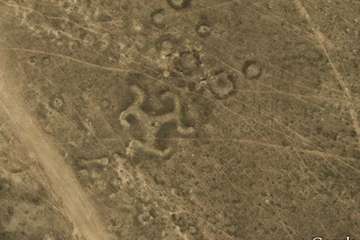
More than 50 geoglyphs, including one shaped like a swastika, have been discovered in northern Kazakhstan.
Credit: Image copyright DigitalGlobe, courtesy Google Earth
More than 50 geoglyphs with various shapes and sizes, including a massive swastika, have been discovered across northern Kazakhstan in Central Asia, say archaeologists.
These sprawling structures, mostly earthen mounds, create the type of landscape art most famously seen in the Nazca region of Peru.
Discovered using Google Earth, the geoglyphs are designed in a variety of geometric shapes, including squares, rings, crosses and swastikas (the swastika is a design that was used in ancient times). Ranging from 90 to 400 meters (295 to 1,312 feet) in diameter, some of them are longer than a modern-day aircraft carrier. Researchers say that the geoglyphs are difficult to see on the ground, but can easily be seen from the sky. [See Photos of the Amazing Geoglyphs in Kazakhstan]
Over the past year, an archaeological expedition from Kazakhstan's Kostanay University, working in collaboration with Vilnius University in Lithuania, has been examining the geoglyphs. The team, which is conducting archaeological excavations, ground-penetrating radar surveys, aerial photography and dating, recently presented its initial results at the European Association of Archaeologists' annual meeting in Istanbul.
Many of the geoglyphs were made of earthen mounds, although one example, a swastika, was made using timber.
Archaeological excavations uncovered the remains of structures and hearths at the geoglyphs, suggesting that rituals took place there, said archaeologists Irina Shevnina and Andrew Logvin, of Kostanay University, in an email to Live Science. Ancient tribes may also have used the geoglyphs to mark ownership of the land, the researchers noted.
"As of today, we can say only one thing — the geoglyphs were built by ancient people. By whom and for what purpose, remains a mystery," said Shevnina and Logvin.
Why they're builders used geometric shapes is also a mystery, although the swastika is an ancient symbol found throughout Europe and Asia.
Geoglyphs around the world
While Peru's Nazca Lines are the world's most famous geoglyphs, archaeological research suggests that geoglyphs were constructed in numerous areas around the world by different cultures.
For instance, in the Middle East, archaeologists have found thousands of wheel-shaped structures that are easily visible from the sky, but hard to see on the ground. Also recently in Russia, archaeologists excavated a geoglyph shaped like an elk, which appears older than the Nazca Lines.
Ancient geoglyphs have also been reported in many other countries, including the United Kingdom, Brazil and even the Southwestern United States. The introduction of high-resolution Google Earth imagery over the last decade has helped both professional archaeologists and amateurs detect and study these enigmatic structures
LiveScience
.

More than 50 geoglyphs, including one shaped like a swastika, have been discovered in northern Kazakhstan.
Credit: Image copyright DigitalGlobe, courtesy Google Earth
More than 50 geoglyphs with various shapes and sizes, including a massive swastika, have been discovered across northern Kazakhstan in Central Asia, say archaeologists.
These sprawling structures, mostly earthen mounds, create the type of landscape art most famously seen in the Nazca region of Peru.
Discovered using Google Earth, the geoglyphs are designed in a variety of geometric shapes, including squares, rings, crosses and swastikas (the swastika is a design that was used in ancient times). Ranging from 90 to 400 meters (295 to 1,312 feet) in diameter, some of them are longer than a modern-day aircraft carrier. Researchers say that the geoglyphs are difficult to see on the ground, but can easily be seen from the sky. [See Photos of the Amazing Geoglyphs in Kazakhstan]
Over the past year, an archaeological expedition from Kazakhstan's Kostanay University, working in collaboration with Vilnius University in Lithuania, has been examining the geoglyphs. The team, which is conducting archaeological excavations, ground-penetrating radar surveys, aerial photography and dating, recently presented its initial results at the European Association of Archaeologists' annual meeting in Istanbul.
Many of the geoglyphs were made of earthen mounds, although one example, a swastika, was made using timber.
Archaeological excavations uncovered the remains of structures and hearths at the geoglyphs, suggesting that rituals took place there, said archaeologists Irina Shevnina and Andrew Logvin, of Kostanay University, in an email to Live Science. Ancient tribes may also have used the geoglyphs to mark ownership of the land, the researchers noted.
"As of today, we can say only one thing — the geoglyphs were built by ancient people. By whom and for what purpose, remains a mystery," said Shevnina and Logvin.
Why they're builders used geometric shapes is also a mystery, although the swastika is an ancient symbol found throughout Europe and Asia.
Geoglyphs around the world
While Peru's Nazca Lines are the world's most famous geoglyphs, archaeological research suggests that geoglyphs were constructed in numerous areas around the world by different cultures.
For instance, in the Middle East, archaeologists have found thousands of wheel-shaped structures that are easily visible from the sky, but hard to see on the ground. Also recently in Russia, archaeologists excavated a geoglyph shaped like an elk, which appears older than the Nazca Lines.
Ancient geoglyphs have also been reported in many other countries, including the United Kingdom, Brazil and even the Southwestern United States. The introduction of high-resolution Google Earth imagery over the last decade has helped both professional archaeologists and amateurs detect and study these enigmatic structures
LiveScience
.

Published on September 23, 2014 13:20
FREE, for a limited time: The Juice and Other Stories by Bill Jones Jr.
 The Juice and Other Stories brings together a collection of 13 tales of romance, science fiction, urban fantasy, and suspense from the imaginative author of The Stream trilogy and the Sci Fi adventure, Hard as Roxx.
The Juice and Other Stories brings together a collection of 13 tales of romance, science fiction, urban fantasy, and suspense from the imaginative author of The Stream trilogy and the Sci Fi adventure, Hard as Roxx.In "Remembering," beings from another world find themselves herded along their own trail of tears. Their leader, Tofray, has the unenviable job of remembering their stories and their suffering. "Mrs. What's-Her-Name" details a woman's struggle to regain her memory, and her life, after a devastating brain injury. In "The Juice," a woman of the street searches for her next client, and promises him surprises. "The Clown Man" visits a beautiful child's dreams and turns them to nightmares; however, Cruz, a dream walker, is there, and he means to keep the girl safe.
The novelette "Manhattan Transference" details the story of Luce, a vaporous visitor from a dying planet, who must find the only robotics expert who can help save the alien race from destruction. Luce's sun will go supernova soon, and without Dr. Roman's help, all of Luce's people will die with it. There is only one problem: Luce's new human form, and the raw emotions that come with it. "Fool O'clock" details a stressful day in the life of Jim Pyle, Deputy Director of the Bureau of Fool Abatement, a government agency tasked with keeping the U.S. safe from fools of all sorts.
In the novelette "Days of the Never Was," three pairs of arguing friends disappear into a strange fog bank and reemerge with their entire worlds turned upside down.
Other stories are "Crazy Magnet," about an investigator with a gift for attracting crazy people; "He Ain't Heavy," a suspense story about twin brothers. "From the Black, the Blues," Sci Fi romance about lovers from two time periods; "The Utopian / Dystopian Compass," Sci Fi; "Reggie and Rocky Vs. Space Monsters from Beneath the Bed," a contemporary fantasy starring 3 and 5-year-old dream walkers; and "Set Fire to the Rain," an excerpt from Emprise.
Note: Some stories contain adult language and situations. Show more Amazon link

Published on September 23, 2014 07:25
Mr. Chuckles discovers Booktrack Studio - soundtracks for books featuring the novels of Mary Ann Bernal and K. Meador

Mr. Chuckles wants you to know that you need to use chrome to access the Booktrack Studio links
The Briton and the Dane: Timeline
Journey to Freedom
The Briton and the Dane
The Briton and the Dane: Birthright
The Briton and the Dane: Legacy
The Briton and the Dane: Concordia
Be sure to leave some stars after you've listened.
Want more info: K. Meador Mary Ann Bernal

Published on September 23, 2014 04:41
History Trivia -Greeks defeat the Persians in the greatest of ancient naval battles, at Salamis
Sept 23
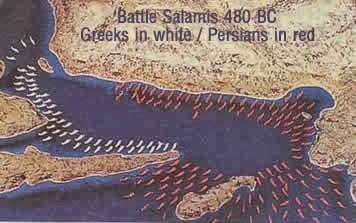
480 BC The Greeks defeated the Persians in the greatest of ancient naval battles, at Salamis, avenging the destruction of Athens. Over 1,000 Persian ships were sunk by fewer than 400 Greek vessels.

63 BC Augustus (Octavian) was born. He was the Roman emperor at the time of Christ, and the founder in 27 BC of the Roman Empire as it was known after the end of the Roman Republic of Julius Caesar's time.

1122 Concordat of Worms brought to an end the first phase of the power struggle between the Papacy and the Holy Roman Emperors.
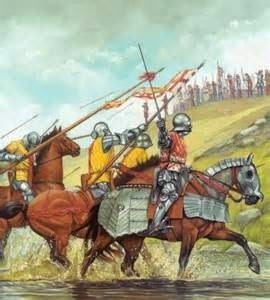
1459 Battle of Blore Heath, the first major battle of the English Wars of the Roses, was fought at Blore Heath in Staffordshire. The Yorkists, though inferior in numbers, were completely victorious.


480 BC The Greeks defeated the Persians in the greatest of ancient naval battles, at Salamis, avenging the destruction of Athens. Over 1,000 Persian ships were sunk by fewer than 400 Greek vessels.

63 BC Augustus (Octavian) was born. He was the Roman emperor at the time of Christ, and the founder in 27 BC of the Roman Empire as it was known after the end of the Roman Republic of Julius Caesar's time.

1122 Concordat of Worms brought to an end the first phase of the power struggle between the Papacy and the Holy Roman Emperors.

1459 Battle of Blore Heath, the first major battle of the English Wars of the Roses, was fought at Blore Heath in Staffordshire. The Yorkists, though inferior in numbers, were completely victorious.

Published on September 23, 2014 04:40



